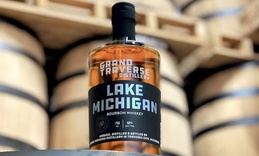
Microplastics Are Everywhere, But Local Organizations Are Fighting Back
Investigations into microplastic pollution are producing alarming results
By Ren Brabenec | July 12, 2025
At a glance, Michigan’s lakes, rivers, and streams look healthy. However, a quirk of human psychology is such that while obvious signs of pollution, like the 2010 Enbridge oil spill in the Kalamazoo River, usually lead to mass mobilization, equally ominous pollution threats that can’t be seen with the naked eye tend to go unnoticed.
And that nearly invisible ominous pollution threat is microplastic.
According to The Watershed Center Grand Traverse Bay, approximately 22 million pounds of plastic debris enter the Great Lakes every year, plastics that break down into tiny pollutants that are now present literally everywhere.
The Science Behind Microplastics
Microplastics are defined as pieces of plastic that are less than five millimeters in size. They can be as small (and even smaller) than one micron in size, which is 70 times smaller than the diameter of a human hair.
“We’ve known about microplastics for decades, particularly in the context of ocean pollution,” says Heather Smith, a scientist and waterkeeper for The Watershed Center. “But it’s only been since the early 2000s that researchers began finding microplastics in the Great Lakes and other Michigan waterways.”
Microplastics are made by the “sloughing off” of plastic material from other, larger objects. According to Smith, every time a polyester jacket is worn, washed, or dried, tiny plastic fibers abrade off the material. Smith identifies polyester, fleece, synthetic textiles, rugs, upholstery, frisbees, kayaks, plastic utensils, water bottles, and a host of other common items that shed tiny bits of plastic as “secondary microplastics.”
“Also, we have what are called primary microplastics, which are plastics that are intentionally made to be that small,” Smith says. “A good example are these minuscule, prefabrication plastic pellets called nurdles designed to be easily modified into other products.” She also points to styrofoam, paint removers, household and industrial cleaning products, reflective paint, and cosmetics as containing primary microplastics.
Whether they were designed to be small or it became that way due to abrasion, according to Smith, once microplastics enter the environment, they begin to break down further via contact with tougher materials and exposure to UV rays and freeze/thaw conditions, all of which make the increasingly smaller (and more numerous) plastics that much more difficult to clean up.
Critically, despite the speed with which plastics break down into smaller and smaller pieces, even extremely small bits of plastic still take approximately 10,000 years to biodegrade fully.
Where are Microplastics Being Found?
“Everywhere we’ve looked, we’ve found microplastics,” Northwestern Michigan College science and math instructor Nick Roster says. “From urban samples right here in town to rural waterways with low population densities, they’re everywhere.”
Roster and his students have been conducting field research since 2022, testing the Boardman-Ottaway and Platte rivers, residential groundwater wells, Traverse City drinking water, and local lakes. “We’ve done air and dirt samples,” Roster says. “We’ve even tested rainwater and earthworms. Every test has found microplastics.”
Now in their fourth year of research, it has not mattered where Roster and his students have tested, what time of year the tests took place, what the water flow of a waterway was like at the time of the test, or the temperature, weather patterns, or population density. In all 22 sites in the Boardman-Ottaway that the team examined, they found microplastics, about 80-85 percent of which were microfibers from clothing.
Further, Roster and his students aren’t the only ones who’ve tested for microplastics in the Grand Traverse area. Their findings were bolstered by the Inland Seas Education Association, which has spent years using its sailboat and a special net to trawl sections of Grand Traverse Bay. That organization has calculated, based on the number of microplastic pieces found per square kilometer, that there are millions of pieces of plastic just in Grand Traverse Bay alone.
Why Should We Be Concerned?
“The simple answer? Microplastics bioaccumulate,” Roster said.
Tiny organisms and fish consume microplastics, and the plastic becomes lodged inside their bodies. Additionally, trillions of microscopic organisms throughout the Great Lakes chew on microplastics, breaking them down into even smaller particles.
Studies on humans are still being done, but there’s evidence to suggest microplastics both collect and contain forever chemicals that can be carcinogenic and toxic. There’s also a study in the New England Journal of Medicine that links microplastic pollution to cardiovascular disease.
Perhaps most unsettling, Smithsonian Magazine reported in February that a study from Nature Medicine journal found “the human brain may contain up to a spoon’s worth of tiny plastic shards—not a spoonful, but the same weight (about seven grams) as a plastic spoon.” They also note that “the amount of microplastics in the human brain appears to be increasing over time: Concentrations rose by roughly 50 percent between 2016 and 2024.”
“For a broader answer about why we should be concerned about microplastics, we have to ask, ‘Why do we want a clean environment in the first place?’” Roster adds. “Beyond all the physical health implications, there’s also the mental health consequences of living in a polluted environment. It’s depressing to see tiny bits of plastic on the beach. It has a psychological effect, which isn’t nothing.”
Science-Based Solutions
Thankfully, the same scientists who are discovering microplastics in northern Michigan are also deeply involved in remediation efforts. The Watershed Center joined the Great Lakes Plastic Cleanup in 2022, a joint effort between Pollution Probe and the bi-national Council of the Great Lakes Region aimed at taking action to clean up Michigan’s waterways.
“Through this partnership and funding provided by Meijer, we started using autonomous robots to clean up beaches and nearshore waterway areas along Grand Traverse Bay,” Smith says.
Smith emphasized that in addition to collecting microplastics, the robots also collect data, which scientists then analyze to determine pollution concentrations. The Watershed Center has also installed devices in parking lot stormwater runoff systems as a way to collect plastics before they enter stormwater drains.
“The robots are also a great community outreach tool,” Smith added. “We train schoolchildren on how to use them, which allows kids to see the value in cleaning up the environment. It’s a great way to inform the community while inspiring action and showing people that while plastics have been a boon to the human race, there is also a downside. We can’t currently live without plastics, but we also have to figure out how to live with them.”
State Policy Needed
Individual efforts towards removing the metaphorical dung heap that is microplastic pollution have value (see the end of the story for tips). But it can feel like using that plastic brain spoon to move a mountain, and Art Hirsch says that state policymaking can make it so the mountain doesn’t exist in the first place…or at least that it isn’t being constantly added to.
Hirsch is a former environmental consultant who now heads the Michigan Microplastics Coalition (MMC), an advocacy group he co-founded in 2022. “The average person consumes about five grams of microplastics per week,” he says, pulling from memory what he calls his list of “not-so-fun fun facts about microplastics.”
“Scientists have found microplastics in zooplankton, meaning plastic is in the bodies of organisms that comprise the very foundation of the food web,” he says. “We should care about the existence of microplastics in our water, air, and food, as they’re not a natural part of the environment and they have negative health implications.”
Soon after founding MMC, Hirsch and his colleagues realized Michigan was decades behind other states in terms of a policy framework that could analyze and clean up microplastic pollution while also regulating future pollution. “Michigan is just one of 12 states that has a ban on local governments imposing bans on single-use plastics,” Hirsch says. “Despite being a leader on so many other environmental issues, Michigan is far behind on microplastics.”
Hirsch says his organization quickly moved to lobby the State of Michigan, and, with the help of a sponsor in State Rep. Rachel Hood, a Democrat from Grand Rapids, MMC put forth a coalition of five bills in 2024:
1. Implement a Microplastics Strategy Plan that will determine how to confront microplastic pollution.
2. Require all washing machines owned by the State of Michigan to use Microfiber Filtration Units and provide a tax rebate for residents.
3. Ban the use of microbeads in things like cosmetics, cleaning materials, and laundry detergents.
4. Develop a pilot study for monitoring drinking water and analyzing microplastic concentration.
5. Require Michigan to enforce regulations on microplastic manufacturers and prevent them from putting microplastics into stormwater systems.
Unfortunately, none of the bills reached the required committees, the legislative session ended, and the makeup of the state House of Representatives shifted following the 2024 election, forcing Hirsch to start over.
“Source control is everything,” Hirsch says with a sigh. “Recycling won’t cut it. Only 9 percent of plastics in Michigan are actually recycled. You have to regulate production and reduce consumption, because once plastic gets into the environment, it’s impossible to clean it up completely. So you have to pressure governments on the local, state, and federal level to regulate corporations and municipalities and simply make them stop polluting.”
Hirsch becomes somber at the end of our interview. “It’s not our choice, but we all ingest microplastic materials from the air we breathe, the food we eat, and the water we drink. These materials are made from carcinogenic and endocrine disrupting chemicals that include PFAS,” he says.
“It seems daunting but there are things we can do to address this pollution via voicing concerns to our legislators, instituting stormwater controls, and changing individual choices we make when purchasing plastic materials. Source control to reduce the manufacturing and disposal of plastics into the environment is the key to managing microplastic pollution in our precious Great Lakes.”
Individual Actions
There’s a lot that Michiganders can do to reduce their plastic pollution output, though both Roster and Smith indicated that lifestyle and consumption habit changes will be required to make a meaningful impact:
- Move away from single-use plastic. Use a steel, reusable water bottle, stop using plastic straws and utensils, and use reusable bags at the grocery store.
- Buy and wear natural fabrics rather than synthetic materials, and opt for cotton linens and towels.
- Clean up plastic in the environment when you see it.
- Don’t buy plastic-encapsulated fertilizer or plastic landscaping fabric for the home garden, and pressure local farmers and co-ops to also forgo these items.
- Line-dry clothes as much as possible, and consider installing washing machine filters. A Philadelphia-based startup called Baleena won first prize at the TC-hosted 2024 Aquahacking challenge for innovating a washing machine filter that can capture microplastics.
- Join groups like The Last Plastic Straw TC, spread the word to community members, and lobby favorite brands to shift away from using plastic in their products.
Roster gave a final comment before hoofing it to his next class. “We first started making plastic in the late 1800s,” he says. “Why? To solve a problem. We started using plastic to make billiard balls, because we had been making them out of ivory. We invented plastic as a way to save the elephants, but just like humans always do, we created a solution that has had its own problems. Now it’s time to start looking for a new solution.”
Trending

Three Holiday Shopping Sprees (and Trees!)
Head north of the 45th parallel this weekend for three chances to get all your holiday shopping done weeks before you’… Read More >>
Writing a Heartfelt Card
They say that letter writing is a lost art, but Thrive 45° Young Professionals Group and the Petoskey Chamber are hoping… Read More >>
Distillery Ups and Downs of 2025: Craft Spirits Industry Is Shifting, but Not Shaken
In late October, scores of people bellied up to the bar to sample a variety of spirits made at Northern Latitudes’ new… Read More >>


